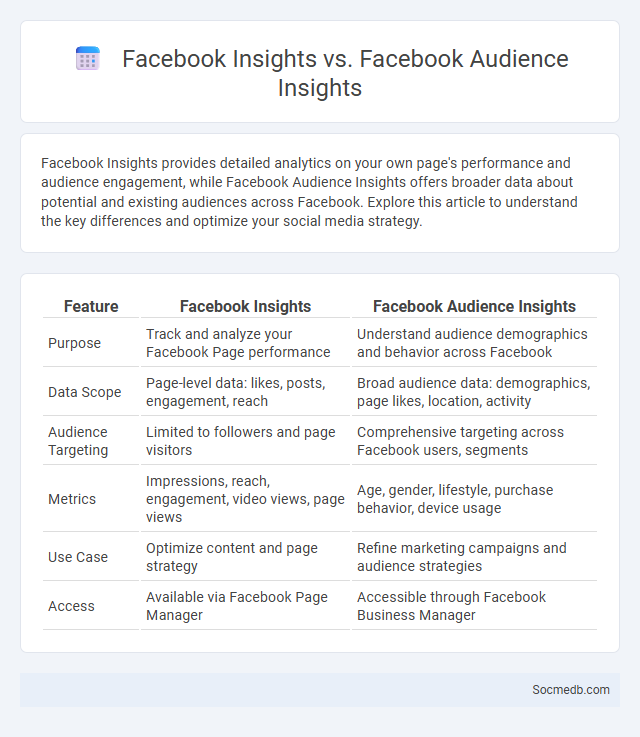
Photo illustration: Facebook Insights vs Facebook Audience Insights
Facebook Insights provides detailed analytics on your own page's performance and audience engagement, while Facebook Audience Insights offers broader data about potential and existing audiences across Facebook. Explore this article to understand the key differences and optimize your social media strategy.
Table of Comparison
| Feature | Facebook Insights | Facebook Audience Insights |
|---|---|---|
| Purpose | Track and analyze your Facebook Page performance | Understand audience demographics and behavior across Facebook |
| Data Scope | Page-level data: likes, posts, engagement, reach | Broad audience data: demographics, page likes, location, activity |
| Audience Targeting | Limited to followers and page visitors | Comprehensive targeting across Facebook users, segments |
| Metrics | Impressions, reach, engagement, video views, page views | Age, gender, lifestyle, purchase behavior, device usage |
| Use Case | Optimize content and page strategy | Refine marketing campaigns and audience strategies |
| Access | Available via Facebook Page Manager | Accessible through Facebook Business Manager |
Overview: Facebook Insights vs Facebook Audience Insights vs Insights
Facebook Insights provides comprehensive analytics on page performance, including metrics like reach, engagement, and user demographics, specifically for page administrators. Facebook Audience Insights offers detailed data on potential and existing audiences, highlighting interests, behaviors, and demographics to help businesses refine their targeting strategies. Insights serves as the broader analytics tool within Facebook's ecosystem, encompassing data from posts, ads, and audience behavior to optimize marketing efforts.
Key Features of Facebook Insights
Facebook Insights offers detailed analytics on your page's performance, including metrics like page views, post reach, and user engagement. You can track demographic data such as age, gender, and location to better understand your audience. These key features empower you to optimize content strategy and improve audience interaction effectively.
Key Features of Facebook Audience Insights
Facebook Audience Insights provides detailed demographic data, including age, gender, relationship status, and education level, to help you understand your target audience better. It also offers information on users' page likes, location, device usage, and purchase behavior, enabling precise ad targeting. Leveraging these insights can enhance your marketing strategy to increase engagement and conversion rates.
Understanding General “Insights” on Facebook
Facebook Insights provides comprehensive data on user engagement, reach, and demographics, enabling you to analyze how your content performs across different audience segments. Metrics such as post reach, page views, and click-through rates offer valuable information to optimize your social media strategy. By leveraging these insights, you can tailor your content to better resonate with Your target audience and improve overall interaction.
Data Types and Metrics Comparison
Social media platforms generate diverse data types, including user-generated content, behavioral data, engagement metrics, and demographic information. Key metrics such as reach, impressions, click-through rates (CTR), and conversion rates provide insights into content performance and audience interaction. Analyzing sentiment scores alongside quantitative data enables comprehensive evaluation of brand reputation and campaign effectiveness.
Audience Targeting Capabilities
Social media platforms offer advanced audience targeting capabilities that enable precise segmentation based on demographics, interests, behavior, and location. Leveraging these tools, your marketing campaigns reach the most relevant users, maximizing engagement and conversion rates. By utilizing data-driven insights, your brand can tailor content to specific audience segments for improved personalization and effectiveness.
Usability and Access: Navigating the Tools
Social media platforms prioritize intuitive usability and seamless access to enhance user engagement and satisfaction. Features like user-friendly interfaces, customizable settings, and multi-device compatibility ensure efficient navigation and accessibility for diverse audiences. Optimizing these tools supports streamlined content sharing and real-time interaction across networks.
Best Use Cases for Each Tool
Instagram excels at visual storytelling, making it ideal for brands aiming to showcase products through photos and short videos. LinkedIn is perfect for professional networking, thought leadership, and B2B marketing by sharing industry insights and connecting with decision-makers. Facebook offers robust community-building features, enabling you to engage customers through groups, events, and targeted advertising campaigns.
Limitations and Challenges
Social media platforms face significant limitations in content moderation, struggling to balance free speech with the removal of harmful or misleading information. Privacy concerns arise as users' personal data can be exploited for targeted advertising and cyber threats. Furthermore, algorithmic biases and echo chambers contribute to polarization and misinformation spread, challenging the credibility and societal impact of social media.
Choosing the Right Platform Insights for Your Marketing Goals
Identifying the most effective social media platform depends on aligning audience demographics and content type with marketing objectives. Platforms like Instagram and TikTok excel for brand awareness and engagement through visual content, while LinkedIn is ideal for B2B marketing and professional networking. Leveraging analytics tools to assess platform performance and user behavior ensures strategic investment and optimized campaign outcomes.
 socmedb.com
socmedb.com